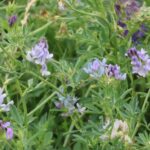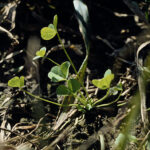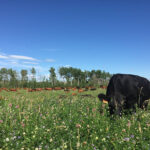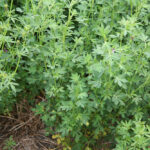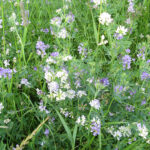Alfalfa
Medicago sativa L.
General Description
Alfalfa is the most widely used perennial, cool season legume on the prairies. It is highly palatable for livestock but can cause bloat if not managed carefully. As the forage species with the most varieties developed, the selected traits and characteristics vary considerably. Thoroughly understand all the characteristics of the alfalfa variety you are purchasing to ensure it meets all of your needs for your site and situation.
Alfalfa is highly palatable for livestock but can cause bloat if not managed carefully. As the forage species with the most varieties developed, the selected traits and characteristics vary considerably. Thoroughly understand all the characteristics of the alfalfa variety you are purchasing to ensure it meets all of your needs for your site and situation.
Alfalfa can have very deep tap roots and a woody crown. There are different types of root systems with different types of alfalfa. The Flemish type has a narrow crown, taproot, and few lateral roots; the Siberian type has a deep set crown and widely branching roots; variegated types can have roots and crowns like either Flemish or Siberian types, or may be an intermediate of the two. Creeping-rooted types have some ability to spread from rhizomes that grow horizontally from primary roots. Shoots may survive as independent plants. Alfalfa crowns are deeper set than most other legumes (except for sweet clover), which increases winter hardiness and survival.
Each alfalfa shoot develops many branches. Each leaf has 3 leaflets with finely toothed margins from midway to the point of the leaflet. Multi-foliate types may have more than 3 leaflets on each leaf. Flowers form from buds at the base of branches, which continue to grow. Flower colour varies with the type of alfalfa.
Type
Tame legume.
Origin
Europe, Middle East, and Siberia. Varieties developed in Canada.
Longevity
3 years to at least 20 years. Alfalfa longevity is affected by variety, management, fertility, timing of grazing by livestock and wildlife, winter hardiness, disease resistance, soil moisture, and pH. Creeping rooted alfalfa survives longer in some regions, whereas tap rooted types tend to survive better in northern regions.
Establishment to at least 5 years. Alfalfa longevity is affected by variety, management, fertility, timing of grazing by livestock and wildlife, winter hardiness, disease resistance, soil moisture, and pH. Creeping rooted alfalfa survives longer in some regions, whereas tap rooted types tend to survive better in drought conditions.
Use
Pasture, hay, stockpiled. An alfalfa stand can serve one or more uses.
Optimal Time of Use
Spring, summer, fall, winter. Cut alfalfa at 10% bloom to optimize both quality and quantity of harvested forage, and to maintain stand productivity. Frequent early cutting will reduce root reserves, potential for growth, and stand longevity. Alfalfa can be stockpiled for later grazing, but quality declines rapidly due to leaf loss. To improve quality, use a mixed stand and swath in a windrow.
Grazing alfalfa beginning at bud stage allows for good regrowth potential. Alfalfa responses well to a rotational grazing. Do not graze to less than 10 cm (4 in) tall as crown buds are critical for regrowth. Tolerance to frequent grazing is highly dependent on the variety and health of plant crowns.
Recovery After Use
Alfalfa requires 60-80 days of recovery in the brown soil zone while less time for recovery in moister soil zones (30-45 days recovery period). Allow growth to bud stage before first grazing or regrazing. Avoid use for 6 weeks before killing frost to reduce winter injury- plants must build up root reserves.
Allow growth to bud stage before first grazing or regrazing. The fall rest period (sometimes called “critical fall harvest period”) for alfalfa is 450 growing degree days, base 5°C—or approximately 6-weeks—before the average date of the first killing frost (-4°C for several hours), when alfalfa stops growing. Not cutting during this period allows alfalfa plants to grow and build upsufficient root reserves to survive the winter and grow more aggressively in the spring. When cut early in the period, the alfalfa will use the existing root reserves for regrowth, “emptying the tank.” Later in the period, the alfalfa uses photosynthesis to produce carbohydrates and stores them as root reserves, “refilling the tank.” Cutting in the middle of the fall rest period (3rd or 4th week), when root reserves will be depleted and there may not be time to replenish them, is usually higher risk than cutting at either the beginning or the endof the period.
Palatability/Nutritional Value
Highly palatable to livestock. Crude protein can be as high as 21% and digestibility as high as 71%. May cause bloat. The greatest bloat risk is when the plants are in the vegetative to early bloom stage of growth.
Highly palatable to livestock. Crude protein can be as high as 21% and digestibility as high as 71%. May cause bloat. The greatest bloat risk is when the plants are in the vegetative to early bloom stage of growth.
Annual Precipitation min/max (mm)
300mm / 1650mm
Drought Tolerance
Good to excellent tolerance. A deep root system allows alfalfa plants to access subsoil moisture more effectively than many other types of forage. Alfalfa varieties noted for hardiness can avoid the effects of drought for up to a year, and will survive longer-term drought by going dormant.
Flooding Tolerance
Withstands 1 to 2 weeks of spring flooding and waterlogged soils before spring growth. Alfalfa requires good drainage while growing.
Winter Hardiness
Fair to excellent. Alfalfa’s hardiness is highly variable depending on variety and management.
Soil Texture Preference
Alfalfa is suited to all well drained sandy, loam, and clay textured soils.
Erosion Control
Moderate ability to control erosion. Creeping rooted varieties are best suited to erosion control.
Salinity Tolerance
Moderate tolerance. Select varieties bred for higher salinity tolerance that have been proven in western Canada.
Acidity Tolerance
Low tolerance. Tolerates soil pH as low as 6.0. Choose varieties noted for better acidity tolerance if necessary.
Alkalinity Tolerance
Moderate to high tolerance.
Seeds per kg
500,000 seeds/kg (227,000 seeds/lb) though Coated seeds will decrease number of actual seeds per kg.
Suggested Mixtures
Alfalfa can be grown on its own in a pure stand or in a mix. Since alfalfa is diverse and adaptable, first decide on a grass species that will achieve your goals and then match an alfalfa variety to it. Forage grasses for a mix might include, but are not limited to, crested wheatgrass, meadow bromegrass, timothy, intermediate wheatgrass, smooth bromegrass, tall fescue and orchardgrass. Note that alfalfa’s persistence in a stand tends to diminish over time, so include an adequate percentage in the seeding mix initially. Including 40-50% grass in a pasture mix with alfalfa reduces the bloat risk.
Alfalfa can be grown on its own in a pure stand or in a mix. Since alfalfa is diverse and adaptable, first decide on a grass species that will achieve your goals and then match an alfalfa variety to it. Forage grasses for a mix might include, but are not limited to bromegrass, timothy, smooth bromegrass, tall fescue, meadow fescue and orchardgrass. Note that alfalfa’s persistence in a stand tends to diminish over time, so include an adequate percentage in the seeding mix initially. Including 40-50% grass in a pasture mix with alfalfa reduces the bloat risk.
Ease of Establishment
Alfalfa establishes easily. Seedlings are vigorous and compete well. Autotoxicity can be a problem between older established alfalfa plants and young seedlings, resulting in stunted young plants.
Competitiveness
Alfalfa is competitive. Creeping rooted alfalfa types are more competitive, and spread by developing new shoots from creeping rootstocks. Alfalfa with hardy crowns can remain healthy and competitive. Stands can thin due to winter injury or other stresses resulting in an increase in grasses or weeds.
Management Considerations
Thoroughly understand all the characteristics of the alfalfa variety you are purchasing to ensure it meets all of your need for your site and situation. Inoculate with Rhizobium meliloti before seeding. Alfalfa generally responds well to fertilizing with phosphorus and sulfur, and often responds well to micronutrient amendments. Avoid close grazing or cutting during the critical fall period 6 weeks before frost. Alfalfa may cause bloat when lush and/or rapidly growing.
Thoroughly understand all the characteristics of the alfalfa variety you are purchasing to ensure it meets all of your need for your site and situation. Inoculate with Rhizobium meliloti before seeding. Alfalfa generally responds well to fertilizing with phosphorus and sulfur, and often responds well to micronutrient amendments. Avoid close grazing or cutting during the critical fall period 6 weeks before frost. Alfalfa may cause bloat when lush and/or rapidly growing.
British Columbia Rangeland Seeding Manual, Saskatchewan Dryland Forage Species Adaptation Tool, USDA Plants Database, Manitoba Forage Adaptation and Comparison Guide, Alberta Forage Manual
British Columbia Rangeland Seeding Manual, Saskatchewan Dryland Forage Species Adaptation Tool, USDA Plants Database, Manitoba Forage Adaptation and Comparison Guide, Alberta Forage Manual, Publication 30 OMAFRA
Alfalfa is adapted to all zones in the Central Interior region. It is important to select varieties that are resistant to verticillium wilt in this region.
Alfalfa is adapted to all zones in the Southern Interior region. It is important to select varieties that are resistant to verticillium wilt in this region.
Select alfalfa varieties noted for winter-hardiness and that have been tested in the Peace-Liard region. Longevity is better with well drained soils & where the pH is 5.9 or higher.
